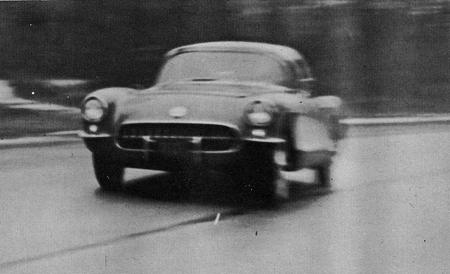Originally published in Sports Cars Illustrated magazine in June 1957.
As these points were observed the engine coolant rose to about 170 degrees F. and the idle dropped to a mere 1200. We had occasion to switch off, and the next lesson in FI came when we tried to restart. Nothing happened; the starter ground on and on and the engine didn’t even cough. So we tried treating it like a flooded carbureted engine and put the throttle on the floor. The engine caught within three spins. The remainder of our test bore out the fact that, while Chev’s FI has the cold-start problem whipped, hot starts are rugged unless you use this simple trick.
Our test car’s 1200 rpm idle seemed excessive and we experimented with this adjustment which is utterly simple and consists of a spring-loaded screw in the throttle body. Playing with this adjustment is not remotely critical and it is easy to obtain a decent idle of 450 to 500 rpm which is identical to the carbureted car. This casts interesting light on the controversy of continuous-flow injection versus timed-flow, Chev’s being the former. However, there is so little torque at this rev level with the competition cam that it is very easy to kill the engine. Experiment showed that about 950 rpm is an all-around good idle speed. With this rapid an idle, you must first briefly engage high gear in order to slip silently into low when standing still.
On both cars, the action of the throttle linkage itself left a lot to be desired. The accelerator pedal travel is so short that you can’t feather these potent engines, and the action is erratic and plagued with lost motion. In the bargain, the dual quads are at their worst at the bottom end. As a result the throttle response of the standard Corvette was unpredictable and slow, though things do happen in a big way after it takes a deep breath. This was still a handicap to clean control and rapid downshifting.
In sharp contrast, and making allowance for the tiny linkage, the throttle response with FI was instantaneous. It’s as though there’s a system of levers between the throttle, pedal and your back. Press the throttle a little bit and your back is pressed, NOW, to the same extent. Slam the throttle down and your back is slammed, NOW, even in high gear. Second cog is so close to high that the slam is only slightly harder, but low gear is fairly low—2.20/1—and it really delivers a punch. These things happened with the dual-quad engine too, but never with the immediacy of the injected Chev, especially at low revs and low manifold vacuum.
The cold figures, available for your inspection, are pretty phenomenal. Injected and carb-fed Corvettes are closely comparable in performance, and both qualify as the fastest-accelerating genuine production cars SCI has ever tested. In fact, up to 80 they’re not so far from the data posted by the Mercedes 300SLR coupe, which is generally regarded as the world’s fastest road car. In low, the Corvettes zoomed up to 55 mph in a shade over five seconds, and in another nine they surged to 95 in second with very exciting verve.
During the runs with the injected car, we were looking mainly for flat spots—the transition points in fuel/air metering that are often among the defects of the carb-fed, rather than injected, engine. There were none. The beef in the FI engine permits you to take off from standstill in top gear just by revving up to 1500 or so and letting the clutch out slowly. Our zero to 60 (actual) time in top gear alone was 13.8 seconds. Then we lugged the engine down to its smooth-running minimum in top gear, 14 mph, and accelerated using both full and partial throttle openings. There was no faltering, there were no flat spots. Power was generated smoothly and at an increasing rate until about 2800 rpm when the cam hit its stride and the car hunkered down and steamed into the distance. Elapsed time for 14 to 60 mph in high was 12.3 seconds, on the injected machine.
The same continuous flow of power held good during hard cornering and braking. Under these conditions with the dual-quad car, the contents of the carb float bowls were slung away from their intended orifices and left the engine gasping for fuel. There was no trace of this with the FI Chev, which feels as though it could be driven upside down.


Leave a Reply